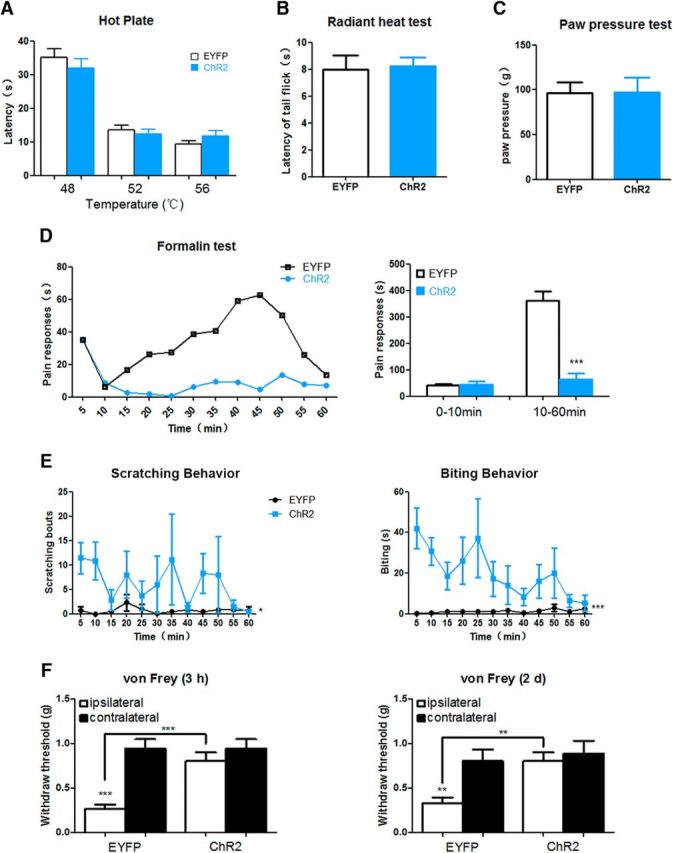Figure 7.

Photoactivation of ACC-DMS has no effect on acute pain sensation, but attenuates inflammatory pain responses. A, B, Mice expressing ChR2-EYFP and EYFP alone responded with a similar paw-withdrawal latency in thermal sensitivity tests (p > 0.05). Thermal pain responses were measured by hotplate (A) and radiant heat (B). Mice of two groups were illuminated by light before placed on hotplate and received radiant heat. A, 48°C, t(16) = 0.8695, p = 0.3974; 52°C, t(16) = 0.6092, p = 0.5510;56°C,t(16) = 1.327, p = 0.2032. B, t(15) = 0.1687, p = 0.8683. C, Mice expressing ChR2-EYFP and EYFP alone showed a comparable mechanical pain sensitivity after light illumination when measured by the paw pressure test (p > 0.05). t(13) = 0.06667, p = 0.9479. D, Mice expressing ChR2-EYFP and EYFP alone showed a similar pain responses in the early phase (0–10 min) when formalin (5%) was injected into the left hindpaw immediately after light illumination. However, during the late phase (10–60 min), mice expressing ChR2-EYFP exhibited significantly lower pain responses relative to mice only expressing EYFP: 0–10 min, t(13) = 0.2348, p = 0.8180; 10–60 min, t(13) = 6.777, p < 0.0001. E, Prominent scratching and biting behaviors could be observed in 1 h after photoactivation of ACC-DMS. After 30 min of stimulation–rest cycles at 473 nm, the scratching and biting behaviors were assessed immediately in the following 1 h per 5 min for the mice expressing EYFP or ChR2-EYFP. Scratching: interaction, F(11,132) = 0.9323; time, F(11,132) = 0.8689; p = 0.037. Biting: interaction, F(11,132) = 1.581; time, F(11,132) = 1.396; p < 0.0001. F, Hyperalgesia evoked by intraplantar injection of CFA was attenuated after photoactivation of ACC-DMS. Mechanical sensitivity of 3 h and 2 d after CFA injection (20 μl) into the left hindpaw was examined immediately for mice with or without photoactivation of ACC-DMS: 3 h, ipsilateral versus contralateral EYFP: t(24) = 5.243, p < 0.0001; ipsilateral ChR2 versus ipsilateral EYFP: t(24) = 4.141, p = 0.0003; 2 d, ipsilateral versus contralateral EYFP: t(24) = 2.956, p = 0.0069; ipsilateral ChR2 versus ipsilateral EYFP: t(24) = 2.956, p = 0.0016. All data are shown as mean ± SEM. p > 0.05, *p < 0.05, **p < 0.01, ***p < 0.001 compared with mice expressing EYFP or EGFP alone group. All data were analyzed by Student's t test except for the figures that time course of pain responses in D–F were analyzed by two-way ANOVA. n = 7–8 mice for each group.
